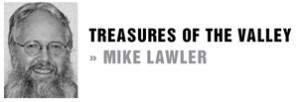A unique feature of our community is the two opposing mountain ranges that embrace our valley. The San Gabriels to the north, imposing and rugged, with rock faces rising nearly straight up, are starkly beautiful. Terrible and majestic, like an Old Testament God, they burn and rain rocks down on us, but provide a gateway to the veritable heaven of the Angeles Forest.
The Verdugos to the south are gentle and lush, rich in growth, with many access points for us to hike and bike into the beautiful and fragrant wilderness. These two mountain ranges give us a peaceful sense of isolation from the big city. They make us feel special and privileged, and for some they are the very reason for living here.
Both the San Gabriels and the Verdugos are today largely protected from development, but that was not always the case. The Verdugos in particular have been eyed by Glendale for development since the post WWII building boom. In the 50s Glendale’s Planning Department began brainstorming vehicular roadways into the mountains, and by the 70s they had put the plan in high gear.
In 1971, Glendale contracted with an outside engineering firm for a set of options and working drawings to exploit the Verdugo Mountains for development, mostly on the CV side. The central theme of the plan called for a scenic road to be built to follow the ridgeline, approximately where the fire road runs across the ridge tops today. The two-lane “Verdugo Mountains Scenic Parkway” would enter the Verdugos near Verdugo Park, and would wind for five miles until it reached a point near the boundary of Burbank’s holdings in the Verdugos. At that point it would intersect with the four-lane “Lowell Avenue Vista Parkway,” which would descend three miles down the ridgelines into the Crescenta Valley.
The plan optimistically envisioned that Burbank and Los Angeles would build similar mountain roads to connect to Glendale’s.
The roadways would include dozens of lookout spots, and vastly increased access for picnicking and hiking. Nature centers and campgrounds were also mentioned in the concept. The document included several options, each with varying degrees of housing development.
The core development plan called for a mountaintop community of 5,000 homes, with a population of about 10 to 15 thousand. The most ambitious option in the document showed a map of the Verdugos fully developed, with another parkway at a lower elevation paralleling the ridge top road. Multiple cul-de-sacs branched off from both main roads, and connector roads reached up from La Crescenta through CV Park, Whiting Woods, Oakmont Woods and from the Oakmont Country Club. Land use along the mountain parkways ran the gamut from low and medium density housing, to college campuses and religious retreats.
An artist’s concept included in the plans shows ridges descending from the mountaintops thickly built with homes on terraces, interspersed with open space, and connected with winding roadways.
A decade earlier this plan would probably have flown, but by the early 70s the environmental movement had added juice to urban wilderness preservation philosophy.
To oppose the City’s ambitious plans, a series of grassroots coalitions rose, dedicated to slowing development of the Verdugos. They were named with clever acronyms, starting in ’71 with S.A.V.E. (Stop Attacks on the Verdugo Environment), followed a few years later by S.W.A.P. (Small Wilderness Area Preservation), which began the task of buying property in the Verdugos to be deeded to Glendale for preservation. In 1997 V.O.I.C.E. (Volunteers Organized In Conserving our Environment) formed to fight the epic Oakmont V battle (which they won), and they continue today advocating for “quality of life” issues such as the preservation of the Verdugo Hills Golf Course.
That Oakmont V battle pretty much sealed the fate of any further development in the Verdugos, and the city’s plans for a Verdugo Scenic Parkway are now shelved in the local history sections of the Glendale libraries. The scenic highway would have been nice, but I like it even better the way it is. The Verdugos will forever be wilderness for us to enjoy.

Mike Lawler is the president of the Historical Society of the
Crescenta Valley. Reach him at
lawlerdad@yahoo.com.
